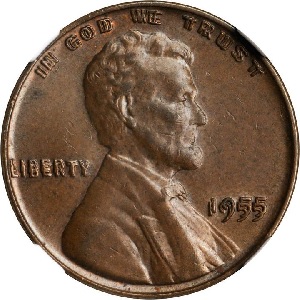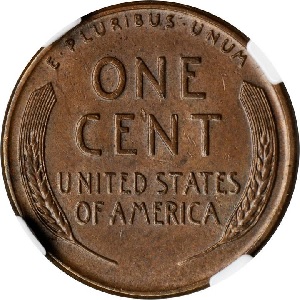1955 Lincoln Cent, Doubled Die
In the summer of 1955, the United States Mint stepped up production of the Lincoln cent to ease shortages throughout the country. In a big rush to maximize output, the coining presses were put on a 24-hour work schedule. To no one’s surprise, the Quality Control department was unable to keep up with the frantic pace.(1)
This backdrop led to the issuance of one of the most celebrated error coins of all time: the 1955 Doubled Die Lincoln cent.
Mechanically speaking, how did the doubling of the die occur?
Dies are made when a working hub strikes an incuse (i.e., indented) image onto the surface of a working die that will subsequently stamp out coins. Multiple hits from the hub are required to fully form the die.(2)
On one obverse die, somehow it slightly rotated between hits from the hub, resulting in a doubling effect of the lettering. This particular die got past the harried inspectors and was eventually placed into service, where the resulting coins were characterized by a “blurriness” of the 1955 date, LIBERTY, and IN GOD WE TRUST. The defect was easily visible to the unaided eye.(3)
The number of 1955 doubled die cents released to the public was approximately 24,000 pieces. This estimate was obtained when veteran coin dealer and author Q. David Bowers, sometime prior to 1964, interviewed Mint personnel who had firsthand knowledge of the event.(4)
According to contemporary accounts, the blundered doubled die was set up in a machine press and put into production, spitting out thousands of coins hourly. Other presses in the nearby vicinity, operating with normal dies, were running at a similar pace.
Finally, someone noticed the pennies accumulating in the bin behind a certain machine didn’t look right, as the lettering on the obverse was out of focus. The machine was shut down and the dies removed for examination. At that point it was realized the obverse die had doubled lettering.
In all, there were about 20,000 erroneous cents in the machine bin. These were easily segregated and later destroyed. After a brief investigation, management learned about 24,000 of the coins with the same problem had earlier been dumped into a larger hopper, mixed in with 10 million other cents.(5)
The only practical alternative to prevent the doubled coins from leaving the Mint was to melt down all 10 million. Since the Chief Coiner was on a tight production schedule, he decided to let them proceed to bagging and onto the Federal Reserve for distribution.
Fascinating Fact: Some of the very first 1955 Doubled Die cents found in circulation were contained in cigarette packs sold through vending machines. The cost of a pack in 1955 was 23 cents, but because vending machines could only accept quarters, the cigarette companies placed two cents inside each pack to be given back as change. This is how many of the doubled cents came to light.(6)
Although some numismatists were interested in the 1955 Doubled Die Lincoln cent from the outset, it took several years before it really caught fire. Since then, it has occupied a place of high regard with collectors of all stripes, ranking as one of the most famous coins from the 20th century.(7)
| Estimated survivors in all grades: 18,450 ?
The survivor estimate from PCGS represents an average of one or more experts' opinions as to how many examples survive of a particular coin in all grades. Survival estimates include coins that are raw, certified by PCGS, and certified by other grading services. Learn more at PCGS. |
| PCGS Rarity Scale: 2.8 ?
The 'PCGS CoinFacts Rarity Scale' assesses the relative rarity of all U.S. coins, based on estimated surviving examples. The scale runs from 1.0 to 10.0. The higher the number, the rarer the coin.
Learn more at PCGS. |
| Click HERE to check for availability on eBay** |
Preview of eBay selection:
 |
 |
| Trendline Avg = 11.77 | CLASSIC RARITY |
Historic Value Trend Charts:
| Last updated 11-11-24 | Return to Key Date Coin List | |
| Compare to Common Date Coin of Same Type | ||
|
|
||
| Download Charts to Your Computer | ||
Sources
1. NGC. 1955 DOUBLED DIE OBV 1C MS.
2. Garrett, Jeff and Guth, Ron. 100 Greatest U.S. Coins, 5th ed. Pelham, AL: Whitman Publishing, 2019.
3. Heritage Auctions. 1955/55 1C Doubled Die. Jul 2005 Auction.
4. Stack's Bowers Galleries. 1955 Doubled Die Obverse. Mar 2005 Auction.
5. Heritage Auctions. 1955/55 1C Doubled Die. May 2005 Auction.
6. PCGS. 1955 1C Doubled Die Obverse, BN (Regular Strike).
7. Heritage Auctions. 1955/55 1C Doubled Die. Jul 2005 Auction.
**Many very fine coin dealers sell on eBay. At any point in time, there may be over one million search results for United States coins. This includes quite a few of the recommendations on our Key Date Coin List.
If you’re thinking about purchasing a rare coin, eBay is certainly worth a look. For your convenience, the links from this site to eBay are coded to bring up only coins certified by PCGS and NGC.
As is always, always the case, never buy a valuable coin from a seller whose trustworthiness cannot be verified. Learn more about this at our chapter Best Places to Buy Coins, which also has a section on doing business on eBay.
In the interest of full disclosure, Rare Coins 101 receives a small commission anytime someone connects to eBay from this site and purchases something.
Coin images by Stack's Bowers Galleries.


